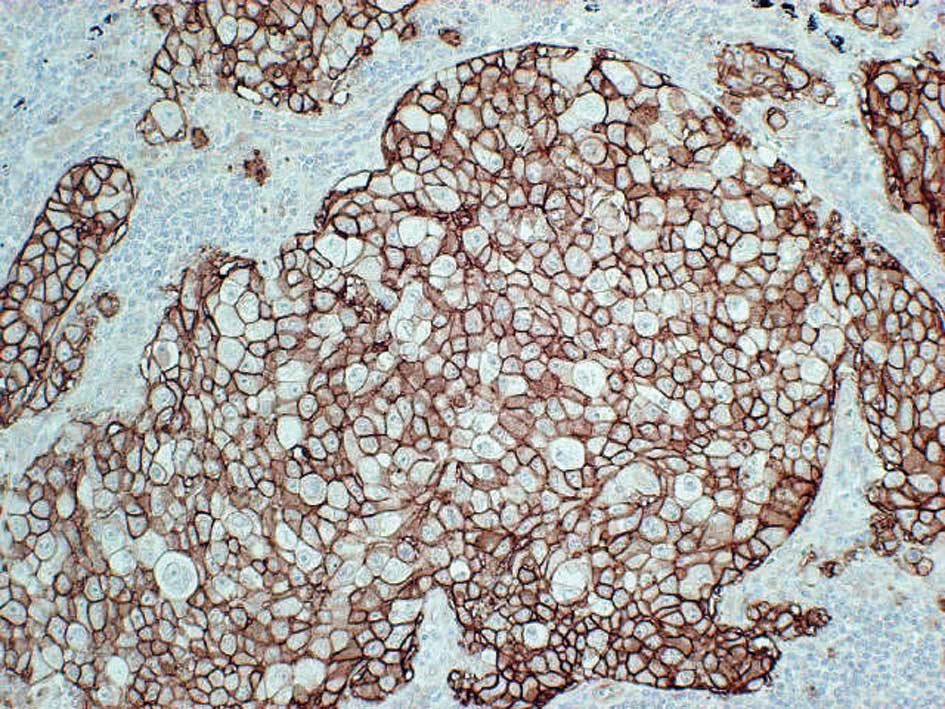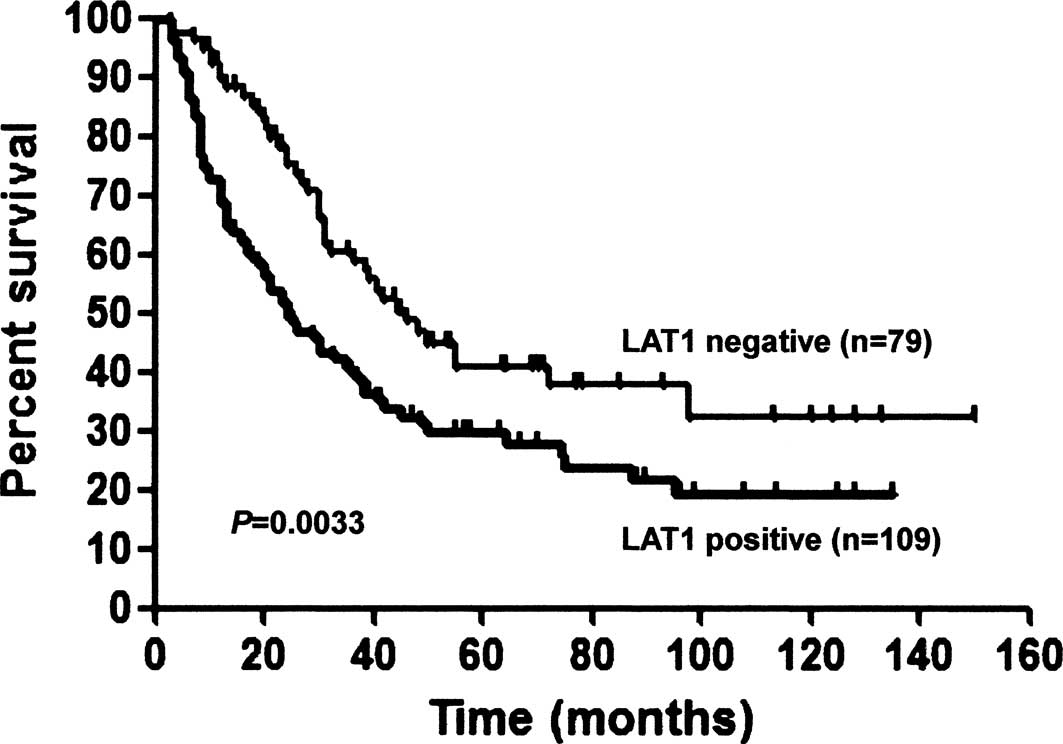|
1.
|
Shottenfeld D: Epidemiology of Lung
Cancer. Lippincott-Raven; Philadelphia, PA: 1996
|
|
2.
|
Graziano SL: Non-small cell lung cancer:
clinical value of new biological predictors. Lung Cancer. 17(Suppl
1): 37–58. 1997. View Article : Google Scholar
|
|
3.
|
Mountain CF: Revision in the International
System for Staging Lung Cancer. Chest. 11:1710–1717. 1997.
View Article : Google Scholar : PubMed/NCBI
|
|
4.
|
Andre F, Grunenwald D, Pignon JP, et al:
Survival of patients with resected N2 non-small cell lung cancer:
evidence for a subclassification and implications. J Clin Oncol.
18:2981–2989. 2000.PubMed/NCBI
|
|
5.
|
Leong SS, Rocha Lima CM, Sherman CA and
Green MR: The 1997 International Staging System for non-small cell
lung cancer: have all the issues been addressed? Chest.
115:242–248. 1999. View Article : Google Scholar : PubMed/NCBI
|
|
6.
|
Jassem J, Skokowski J, Dziadziuszko R, et
al: Results of surgical treatment of non-small cell lung cancer:
validation of the new postoperative pathologic TNM classification.
J Thorac Cardiovasc Surg. 119:1141–1146. 2000. View Article : Google Scholar
|
|
7.
|
Clinical practice guidelines for the
treatment of unresectable non-small cell lung cancer: adopted on
May 16, 1997 by the American Society of Clinical Oncology. J Clin
Oncol. 15:2996–3018. 1997.PubMed/NCBI
|
|
8.
|
Christensen HN: Role of amino acid
transport and countertransport in nutrition and metabolism. Physiol
Rev. 70:43–77. 1990.PubMed/NCBI
|
|
9.
|
McGivan JD and Pastor-Anglada M:
Regulatory and molecular aspects of mammalian amino acid transport.
Biochem J. 299:321–334. 1994.PubMed/NCBI
|
|
10.
|
Oxender DL and Christensen HN: Evidence
for two types of mediation of neutral amino acid transport in
Ehrlich cells. Nature. 197:765–767. 1963. View Article : Google Scholar : PubMed/NCBI
|
|
11.
|
Kanai Y, Segawa H, Miyamoto K, Uchino H,
Takeda E and Endou H: Expression cloning and characterization of a
transporter for large neutral amino acids activated by the heavy
chain of 4F2 antigen (CD98). J Biol Chem. 273:23629–23632. 1998.
View Article : Google Scholar : PubMed/NCBI
|
|
12.
|
Yanagida O, Kanai Y, Chairoungdua A, et
al: Human L-type amino acid transporter 1 (LAT1): characterization
of function and expression in tumor cell lines. Biochim Biophys
Acta. 1514:291–302. 2001. View Article : Google Scholar : PubMed/NCBI
|
|
13.
|
Ohkame H, Masuda H, Ishii Y and Kanai Y:
Expression of L-type amino acid transporter 1 (LAT1) and 4F2 heavy
chain (4F2hc) in liver tumor lesions of rat models. J Surg Oncol.
78:265–272. 2001. View
Article : Google Scholar : PubMed/NCBI
|
|
14.
|
Kaira K, Oriuchi N, Imai H, et al:
Prognostic significance of L-type amino acid transporter 1
expression in resectable stage I–III nonsmall cell lung cancer. Br
J Cancer. 98:742–748. 2008.
|
|
15.
|
Kaira K, Oriuchi N, Imai H, et al:
Expression of L-type amino acid transporter 1 (LAT1) in
neuroendocrine tumors of the lung. Pathol Res Pract. 204:553–561.
2008. View Article : Google Scholar : PubMed/NCBI
|
|
16.
|
Nakanishi K, Ogata S, Matsuo H, et al:
Expression of LAT1 predicts risk of progression of transitional
cell carcinoma of the upper urinary tract. Virchows Arch.
451:681–690. 2007. View Article : Google Scholar : PubMed/NCBI
|
|
17.
|
Nawashiro H, Otani N, Shinomiya N, et al:
L-type amino acid transporter 1 as a potential molecular target in
human astrocytic tumors. Int J Cancer. 119:484–492. 2006.
View Article : Google Scholar : PubMed/NCBI
|
|
18.
|
Chairoungdua A, Segawa H, Kim JY, et al:
Identification of an amino acid transporter associated with the
cystinuria-related type II membrane glycoprotein. J Biol Chem.
274:28845–28848. 1999. View Article : Google Scholar : PubMed/NCBI
|
|
19.
|
Matsuo H, Tsukada S, Nakata T, et al:
Expression of a system L neutral amino acid transporter at the
blood-brain barrier. Neuroreport. 11:3507–3511. 2000. View Article : Google Scholar : PubMed/NCBI
|
|
20.
|
Buck AC, Schirrmeister HH, Guhlmann CA, et
al: Ki-67 immunostaining in pancreatic cancer and chronic active
pancreatitis: does in vivo FDG uptake correlate with proliferative
activity? J Nucl Med. 42:721–725. 2001.PubMed/NCBI
|
|
21.
|
Weidner N, Semple JP, Welch WR and Folkman
J: Tumor angiogenesis and metastasis-correlation in invasive breast
carcinoma. N Engl J Med. 324:1–8. 1991. View Article : Google Scholar : PubMed/NCBI
|
|
22.
|
Mineo TC, Ambrogi V, Baldi A, et al:
Prognostic impact of VEGF, CD31, CD34 and CD105 expression and
tumor vessel invasion after radical surgery for IB–IIA non-small
cell lung cancer. J Clin Pathol. 57:591–597. 2004.PubMed/NCBI
|
|
23.
|
Fucks BC, Finger RE, Onan MC and Bode BP:
ASCT2 silencing regulates mammalian target-of-rapamycin growth and
survival signaling in human hepatoma cells. Am J Physiol Cell
Physiol. 293:55–63. 2007. View Article : Google Scholar : PubMed/NCBI
|
|
24.
|
Kaira K, Oriuchi N, Imai H, et al: L-type
amino acid transporter 1 (LAT1) and CD98 expression in the primary
site and the metastatic site of human neoplasms. Cancer Sci.
99:2380–2386. 2008. View Article : Google Scholar : PubMed/NCBI
|
|
25.
|
Rintoul RC, Buttery RC, Mackinnon AC, et
al: Cross-linking CD98 promotes integrin-like signaling and
anchorage-independent growth. Mol Biol Cell. 13:2841–2852. 2002.
View Article : Google Scholar : PubMed/NCBI
|
|
26.
|
Esteban F, Ruiz-Cabello F, Concha A, Perez
Ayala M, Delgado M and Garrido F: Relationship of 4F2 antigen with
local growth and metastatic potential of squamous cell carcinoma of
the larynx. Cancer. 66:1493–1498. 1990. View Article : Google Scholar : PubMed/NCBI
|
|
27.
|
Kaira K, Oriuchi N, Otani Y, et al:
Fluorine-18-α-methyltyrosine positron emission tomography for
diagnosis and staging of lung cancer: a clinicopathological study.
Clin Cancer Res. 13:6369–6378. 2007.
|
|
28.
|
Martin B, Paesmans M, Mascaux C, et al:
Ki-67 expression and patient survival in lung cancer: systematic
review of the literature with meta-analysis. Br J Cancer.
91:2018–2025. 2005. View Article : Google Scholar : PubMed/NCBI
|
|
29.
|
Han H, Silverman JF, Santucci TS, et al:
Vascular endothelial growth factor expression in stage I non-small
cell lung cancer correlates with neoangiogenesis and a poor
prognosis. Ann Surg Oncol. 8:72–79. 2001. View Article : Google Scholar : PubMed/NCBI
|
|
30.
|
Oriuchi N, Higuchi T, Ishikita T, et al:
Present role and future prospect of positron emission tomography in
clinical oncology. Cancer Sci. 97:1291–1297. 2006. View Article : Google Scholar : PubMed/NCBI
|
|
31.
|
Kaira K, Oriuchi N, Otani Y, et al:
Diagnostic usefulness of fluorine-18-α-methyltyrosine positron
emission tomography in combination with
18F-fluorodeoxyglucose in sarcoidosis patients. Chest.
131:1019–1027. 2007.
|
|
32.
|
Inoue T, Koyama K, Oriuchi N, et al:
Detection of malignant tumors: whole-body PET with
fluorine-18-α-methyl tyrosine versus FDG-preliminary study.
Radiology. 220:54–62. 2001.
|
|
33.
|
Tomiyoshi K, Amed K, Muhammad S, et al:
Synthesis of new fluorine-18 labeled amino acid
radiopharmaceutical: L-F-alpha-methyl tyrosine using separation and
purification system. Nucl Med Commun. 18:169–175. 1997. View Article : Google Scholar
|
|
34.
|
Kim DK, Kanai Y, Choi HW, et al:
Characterization of the system L amino acid transporter in T24
human bladder carcinoma cells. Biochim Biophys Acta. 1565:112–122.
2002. View Article : Google Scholar : PubMed/NCBI
|
|
35.
|
Kaira K, Oriuchi N, Shimizu K, et al:
Evaluation of thoracic tumors with 18F-FMT and
18F-FDG PET-CT: a clinicopathological study. Int J
Cancer. 124:1152–1160. 2009.PubMed/NCBI
|
|
36.
|
Kim CS, Cho SH, Chun HS, et al: BCH, an
inhibitor of system L amino acid transporters, induces apoptosis in
cancer cells. Biol Pharm Bull. 31:1096–1100. 2008. View Article : Google Scholar : PubMed/NCBI
|
|
37.
|
Berghmans T, Meert AP, Martin B, Ninane V
and Sculier JP: Prognostic role of epidermal growth factor receptor
in stage III non-small cell lung cancer. Eur Respir J. 25:329–335.
2005. View Article : Google Scholar : PubMed/NCBI
|
|
38.
|
Berghmans T, Mascaux C, Martin B, Ninane V
and Sculier JP: Prognostic role of thyroid transcription factor-1
in stage III non-small cell lung cancer. Lung Cancer. 52:219–224.
2006. View Article : Google Scholar : PubMed/NCBI
|
















